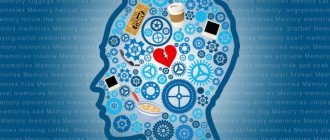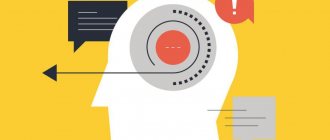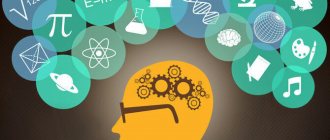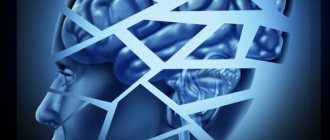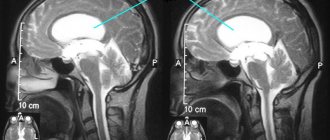Preschool age is a time of rapid development of higher mental functions. Every new year and month brings qualitative changes; thinking, speech, attention, and the emotional-volitional sphere change. Therefore, the development of memory in preschool children, along with other functions, is the primary task of parents, the relevance of which cannot be overestimated.
Definition of memory and its essence
Memory is a cognitive process that consists of fixing perceived experience, holding it in a state of active attention for some time with the ability to reproduce it later, including the processes of remembering, storing, reproducing and forgetting information.
The neurophysiological essence of memory is the formation of stable neural connections (synapses) in the cerebral cortex.
There are such types of memory as:
- involuntary - impressions, usually colored by vivid emotions, are preserved by themselves;
- voluntary—the volitional component and associations are involved.
Memories associated with different areas of life can be imprinted on neurons located nearby in the cerebral cortex: the memory of the smell of cocoa is located next to images of being in kindergarten, which is why the smell evokes images associated with that period of life. On the contrary: the color green is associated with a Christmas tree, so information about everything green is located next to memories of Christmas trees. The example is conditional, but this is how associations work. It is believed that the ability to voluntarily memorize is established in preschool age, which later affects learning and personality formation.
There is an innate ability to remember, due to the natural plasticity of brain tissue (“mneme”) - mechanical, or immediate memory. This characteristic can really be improved with the help of mnemonic techniques and different ways of assimilating information. The development of cultural memory can be practiced throughout life, but techniques learned in childhood work better than others.
CHARACTERISTIC FEATURES OF MEMORY IN PRESCHOOL CHILDREN
In preschool age, certain features of the formation and development of memorization are distinguished. These include:
· Predominance of figurative involuntary memory in preschoolers.
· Acquisition by the child of the intellectual character of memorization. Memory is steadily united with thinking and speech.
· The development of verbal-semantic memory expands the child’s area of cognition.
· Arbitrary memory begins to form.
· In preschool age, special prerequisites are formed that transform the memorization process into a certain mental activity.
· Memory begins to influence the development of the child as an individual.
A sufficient level of memory in a preschooler also increases the child’s self-confidence.
Types of memory
Based on the duration of storing information, memory is divided into two types:
- Short-term - memorization for a short (several minutes) period, rapid forgetting. For example, numbers during oral counting, a passage of text when taking notes, writing from dictation, people in the room where they were just now. Such information is not stored for a long time and is erased after a while.
- Long-term - postponing memories, information, impressions, skills for a long time. Helps to accumulate and combine life experiences that shape a person’s personality. It can be mechanical or semantic (associative).
According to the leading analyzer, memory is divided into the following types:
- visual - memorizing visible images;
- auditory - remembering what is heard;
- tactile, motor (motor) - memorization of sensations and movements;
- emotional - capturing vivid emotions;
- verbal-logical - speech structures and semantic connections are assimilated.
Several species are involved in the process at the same time, rarely only one of them.
BASIC TYPES OF MEMORY
Human memory is usually classified by type. In modern psychology, classification on several grounds is most widespread and used.
Features of mental activity divides memory into:
· Motor. This type of memorization is expressed by memorizing and then reproducing various movements, ranging from the simplest to the most complex. It is this memory that helps the baby learn to roll over, sit, walk, and subsequently write, play certain sports, drive a bicycle and a car.
· Emotional. When using this type of memorization, a person retains experiences and everything connected with them.
· Figurative memory is also called visual memory. That is, the proposed information is remembered in the form of certain images, smells, that is, the sense organs are involved in the formation of figurative memory. Figurative memorization in some people has certain characteristics, these often include manifestations of eidetism. At the same time, a person can describe the images he previously perceived in the smallest detail; such memory often occurs in children of preschool and school age.
· Verbal-logical. In this type of memorization, the products of human culture are assimilated through communication and words.
Memory is also divided according to the duration of its storage, that is, it can be short-term, long-term or operational. Short-term memory is present every day in every person. That is, a few minutes after visiting a store, a person can, for example, describe the buyer standing in front of the queue. As a rule, this information is gradually erased throughout the day.
The features of our memory are also divided by the nature of its purposes. It can be involuntary or voluntary. Involuntary memorization occurs even if a person does not make any effort to do so. Voluntary occurs when a person specifically expends some effort to remember the information he needs.
Long-term memory is considered the most important memory in the development of a person as an individual.
memory is considered the most important memory in the development of a person as an individual . It is thanks to this type of memorization that each person accumulates his life experience. Information with this type of memory is remembered for a long time for completely different reasons. Both special memorization and vivid emotions experienced by a person at a certain moment in life help in this. A person needs RAM to support his activities. The necessary information can either be forgotten due to its uselessness, or pass into long-term memory.
Depending on the method of memorization, memory is divided into semantic and mechanical. Repeated repetition without establishing meaning between opposing objects is rote memory. Semantic memorization is based on establishing some connection between objects.
Peculiarities of memory of preschool children
Preschool is considered the period from 4 to 6-7 years. At this age, children speak well, are capable of constructing complex sentences, their attention and thinking are actively developing, and the ability to analyze appears. Mental abilities develop as the child prepares for school, especially if parents prepare him purposefully, and in the first school year, in order to cope with the multiply increased mental load. Features of memory development during this period include the rapid formation of a volitional component and voluntary memorization.
In younger preschoolers, figurative memory predominates: they remember what impressed them most. Insignificant, but striking features of an object are highlighted, while important, but not so noticeable, features can be ignored.
The formation of fine motor skills contributes to the development of motor memory in children of older preschool age. When certain actions are performed frequently, their automation is achieved. The future first grader learns to sew, cut out complex details from paper with scissors, draw, and sculpt. Gross motor skills develop: the baby is able to learn play and dance movements, having time to observe others and coordinate his actions with them.
The development of speech function occurs with great productivity during this period. At four or five years old, most children can read, listen to stories, fairy tales, reproduce heard texts in their own words, express their thoughts coherently, and recite short poems by heart. This ability develops in communication with adults and peers.
Memory development in preschoolers begins with involuntary memorization. If a poem or story is emotionally charged, the child will easily remember it. Everything unusual that occurs in life is quickly stored in the head for a long time. From the age of four, the child learns to connect the volitional component to memorization, and one can begin to develop his voluntary memory. Self-control arises, and gradually the preschooler himself learns to remember information that will be useful in the future.
A growing person develops personal experience based on remembering events and experiences associated with them. The baby shares this experience with others, talking coherently about it: an interesting trip, a trip to the zoo, resentment, painful sensations when visiting a doctor - all such vivid impressions remain for a long time.
Involuntary memory develops as a result of regular observations, for example, of living nature, so it is advisable to focus on such things. The free skill develops faster if you often encourage the preschooler to reproduce the accumulated experience: teach him to play, write and tell stories, memorize poems, songs, and fairy tales.
Simple workouts
Achieving memory development in preschoolers is not as difficult as it might seem at first glance. You just need to provide the child with comfortable conditions, as well as put into practice the techniques you like, but do this in such a way that the child does not experience negative emotions during the training process. To fulfill the last condition, it is necessary to take into account the interests of children, giving them the right to vote in the choice of technology for development. It’s best to start with methods that are simpler and more accessible in everyday life.
Poems
At school, many children begin to dislike poems, because... It is extremely difficult for them to cope with memorizing long poetic works. If you learn interesting rhymes before school, then this outcome can be prevented. At the same time, memorizing even light quatrains will be beneficial, making the child’s memory much stronger.
It is important that the child himself likes the poem. At the same time, parents should in every possible way encourage his desire to learn a few more lines. It’s enough to simply praise the baby, saying how great he is. It is best to approach learning poems at the age of 5-6 years.
Memorizing information
Simple memorization is a popular method for schoolchildren to memorize important information. But it can be extremely effective for preschoolers too. This is due to the fact that with active memorization, the child’s memory is seriously trained, becoming stronger. For these purposes, you can select short, simple rules or interesting facts. The child will have to reproduce the memorized text as accurately as possible.
It is not recommended to get carried away with this method, because... it may have a negative impact on future learning. If a child gets used to memorization, then involuntary memory will work less effectively, and the desire to understand and understand the subject will be blocked by attempts at simple memorization.
Reading
Literature can also be very useful in developing memory. If the child has already learned to read, then he can be given simple books that he can master. Preschoolers who cannot yet read even a short story on their own should be helped by their parents. You just need to read any interesting book to your baby before bed or during the day.
After reading, parents should discuss the story they read with their child. You can ask for comments on certain events, tell your impressions, or offer to find references to certain things on the pages of the work. It is also advisable to give the child the task of briefly retelling the story he heard.
What I saw
A very simple method to strengthen your memory. It represents an interesting interaction between parents and child. The idea is that adults ask the child questions or ask him to talk about any recent event. For example, going to the circus or an evening walk. You need to choose activities that evoke a lot of emotions in your child.
With such discussions, the child will develop memory, sociability, outlook, as well as a desire to show increased attention to detail. It is important to ask questions with motivation, so that the child understands why he is being asked about this, and the conversation does not resemble an interrogation.
Associations
One of the most effective mnemonic techniques is association. They are very often used by children to memorize information, but when used purposefully, this method leads to memory strengthening. Its essence is to create associative chains in which each item is connected to each other by a certain characteristic. This memorization allows you to retain the maximum amount of information in your memory.
It is recommended to use the technique for preschoolers 6-7 years old. Younger children will not be able to fully use all the conditions of associative chains.
Scientists have proven that 70% of information received is forgotten the very next day, another 25% is forgotten within a month. It turns out that of the memories that are not further consolidated, only 5% remains in the head.
Peculiarities of learning material by preschoolers
Voluntary memorization in children under 7 years of age depends on the following factors:
- the content of the proposed material: how interesting it is, whether it evokes emotions, how it is presented;
- learning process: there must be a certain logic that is understandable to the child’s mind and easily retained in the head for a long time;
- motivation: it is necessary to explain why this knowledge will be needed in the future;
- control of long-term memorization: you need to check the degree of assimilation of the material over time.
It is important to remember that for a preschooler, the leading form of activity, according to L.S. Vygotsky, is play, so memorization should occur during the game. You shouldn’t get tired and lose interest, this will lead to the opposite result.
Development of memory in schoolchildren
When a child enters first grade, he immediately finds himself in an unfamiliar environment. From the first days of school, he has to memorize large amounts of information. As the student gets older, the workload will increase. If he does not have good memory and attention, then studying will be more and more difficult for him every year. That is why it is necessary to pay special attention to the development of memory in a child over 7 years old.
It is important to teach him to remain focused on lessons and to voluntarily remember the information that he receives from the teacher’s lectures and textbook texts. To do this, you need to regularly perform various exercises that are aimed at improving the skills of perception and assimilation of new knowledge. No less useful for memory development will be reading and discussing books, memorizing poems, writing summaries - that is, those tasks that the school curriculum already includes.
Sometimes such simple training is enough to improve memory and attention. But if it is still not easy for a child to cope with the academic load and remember large amounts of material, then he needs additional training.
Methods for developing visual memory
"Camera"
The child is shown the drawing for a few seconds and given the task of “being a camera”: remember it in detail. Then they remove it and ask you to talk about what you saw, trying to remember as many details as possible. They show the drawing again, check what was reproduced correctly and what was forgotten. If it is difficult for your child to complete a task, you need to say: “Please try to remember more next time.” You need to talk to him kindly, and not scold him if something doesn’t work out. This recommendation applies to all games and educational techniques.
"Find the Differences"
The subject is shown two almost identical pictures, where several elements that need to be detected differ. The first is shown a picture where all the elements are present, they are asked to remember it, the second is a picture where some details are missing. Gradually, the child learns to accurately remember the drawing in the smallest detail and to find differences very quickly.
"What is missing?"
An exercise similar in meaning to the previous one, but different in form. They show a set of small objects lying on the table (pebbles, jewelry, Kinder Surprise toys, etc.), ask them to look at them for a few seconds and remember. Then the objects are covered with a scarf, the child is asked to close his eyes or turn away, at this time one object is removed. After which they are allowed to open their eyes and objects are shown again. You need to correctly answer which one is missing.
"What changed?"
This game is for a group of children. The presenter asks one of them to stand up and come to him, and the rest - to look at him for a few seconds and remember well. The presenter takes the baby out the door and changes something in his appearance, not particularly noticeable: he puts on or takes off jewelry, ties a bow, combs his hair in a different parting, asks him to unbutton a button. After which the child returns to the other children, who must guess what has changed. You can make the game a team game, assigning points to each team for attentiveness.
“Describe your neighbor”
The game is suitable for activities with children sitting nearby, for example, in kindergarten. The guys are given the task of looking at their neighbor for a short time, turning away and describing him from memory. In turn, the neighbor does the same. The one who gives the most details wins.
"Schulte tables"
A technique used by psychologists to determine attention switchability. It can be used to develop visual memory in children of primary school age. Children are shown tablets with letters, numbers or simple drawings, are asked to look at the tablet for a while, and then reproduce what they remember.
The most important type of attention to develop
This, of course, is voluntary attention. What do you need to know about its development in a child?
From birth, the child has direct and involuntary attention.
By the end of the first year of life, the prerequisites for the future development of voluntary attention appear, he begins not only to react, but also to do something independently at will, he directs his activity to what interests him.
He tries to do something, take it out, examine it, taste it, throw it, throw it away)
At 2-3 years of life , reactive voluntary attention develops, arising under the influence of an adult’s speech, his facial expressions, gestures, as well as under the influence of the direction of the child’s gaze at the named object.
The child himself begins to use these means to attract other people.
4.5-5 years is the beginning of active voluntary and mediated attention. A child can direct his attention to some object when an adult draws his attention to it, under the influence of complex speech instructions.
The child begins to control his own attention (drawings, signs).
By the age of 5-6 years, under the influence of independent instructions, the child develops elementary forms of voluntary attention; he can describe what he is doing out loud, and this speech guides his attention.
It has a small volume and is not yet quite unstable.
Junior schoolchildren. At this age, further development of voluntary and indirect attention occurs. But it lags behind the attention of an adult in all respects: stability, distribution, concentration, switchability and volume.
Only by adolescence does the level of development of attention reach that of an adult.
In games we will develop just these properties of attention:
- stability - the ability to remain at a certain level for a long time
- distribution - the ability to split into several tasks at once
- concentration - the ability to concentrate on one thing, thought, image and distract attention from everything else
- switchability - switching from one object to another (speed or speed)
- volume - the maximum number of objects held simultaneously
Development of associative memory
"Association Game"
The child is shown an object (for example, a ball) and asked to tell what it is: red, bright, big, bouncy, smooth, rubber. This is a simple exercise, but it reliably forms associative connections. You can repeat it often, with different objects that the child encounters everywhere - at home, on the street, in kindergarten. This game also develops observation skills.
"I know five..."
A ball game, more suitable for girls. At the same time, they take the ball in their hands, hit it off the floor, repeating: “I know five names of boys: Kolya - one, Petya - two, Vanya - three, Lesha - four, Igor - five...” and so on Further. You can repeat it with anything: five names of girls, five names of cities, five names of rivers, five pets, and the like. The game also develops the ability to generalize and synthesize.
"Item Comparison"
The child is offered two or more objects and needs to be told what they have in common and what is different. This exercise, in addition to the main task, develops the ability for comparative analysis and synthesis.
Do you already know what types of attention there are?
Depending on the participation of the will, there are:
- voluntary attention
- involuntary attention
Voluntary attention is attention when a child consciously and purposefully pays attention to some object and maintains attention on it for a certain time.
Involuntary attention is attention that arises against the will of the child, on its own; it practically cannot be consciously regulated by it.
This is attention to a loud sound, a flash of light, or some unusual or disgusting smell.
It was suggested that there is still post-voluntary attention, as an independent type of attention that arises some time after a person voluntarily maintains attention on some object.
So, after a while, it is no longer necessary to exert an effort of will in order to maintain attention on this object.
However, later scientists came to the conclusion that this involves a transition from voluntary to involuntary attention and does not form an independent type.
Depending on the use of special means for managing attention, the following are distinguished:
- direct attention is the attention attracted by the object itself that is interesting to a person, without the use of any additional means.
- indirect attention is attention that arises and is controlled through additional means, indirectly related or not related to the object itself. For example, by using symbols (an arrow pointing to an object), words (you can say, for example, “pay attention...” or “look”).
Development of motor and tactile memory
"Puppeteer"
The baby is asked to close his eyes, then the leader, holding him by the shoulders from behind, leads him along a certain pre-selected route, for example: three steps to the right, two to the left, one step back, two forward. Having opened his eyes, the child must independently repeat the movements. You can start with a simple sequence, gradually increase the route, and complicate the tasks.
"Graphic dictation"
The exercise is related to both visual memory and fine motor skills. An adult draws a pattern on the board or in a notebook, asking the children to reproduce it. You can start with simple ones, gradually move on to more and more complex tasks (increase the number of colors, the complexity of the pattern itself, change the rhythm of the pattern, etc.)
“Reproducing a drawing from memory”
This exercise is similar to the previous one, but here the subjects are first presented with a certain drawing consisting of several parts, asked to look at it and remember, and then reproduce a certain part of it.
For example, the picture shows three cats - draw a second cat. Two trees - draw the one on the right, and so on.
"Do as I do".
The child and the leader each take 6 matches. First, the presenter lays out any drawing or pattern from matches, then shows it for a couple of seconds, and the child must repeat it. If two children are playing, they can change roles. Gradually the number of matches increases to 12-15.
"Geometric figures"
For this game you need a set of geometric shapes or other simple objects and a bag in which they will be placed. The leader names the figures one by one, and the children find them in the bag by touch, placing them in order in front of them on the table.
Memory development from 12 to 16 years
The development of memory in school-age children is one of the “elephants” on which good academic performance rests. Speaking about the development of thinking, it is necessary to pay attention to the education of memory - in other words, the child must want to remember, reproduce, realize. And this can only be achieved by completing interesting, exciting and illustrated tasks.
Parents who resort to the services of psychologists are faced with the problem of the quality of memory of schoolchildren as a result of fading interest in academic subjects. How to improve a child’s memory if he has low self-esteem? What methods of motivation can be used to revive the desire for intellectual, creative realization of a teenager at school?
Classes at the AMAKids Intelligence Development Academy are aimed at various age groups of students. Mental arithmetic, based on a unique method of counting, is an opportunity to develop and improve the memory of a child of primary and secondary school age, as evidenced by reviews from numerous clients.
The formula for success in preparing a child for adult, independent life consists of conceptual methodological assistance from parents and mentors, laying a layer of necessary knowledge on top of the genetic base. Do you want your child to be comprehensively developed? Do you dream of giving your child a professional start in the humanities and exact sciences? Are you striving to organize extracurricular leisure time for your daughter or son in a creative and vibrant way, instilling a love of music and the visual arts?
Call or email AMAKids and we will help you make sure your child is a natural genius.
Development of auditory and verbal memory
"Ten Word Method"
This method is used to test the development of short-term memory in primary schoolchildren, but it can also be used for training to increase its volume. The child is asked to memorize, then ten words are read at a moderate pace, with a short pause after each, and then they are asked to reproduce them out loud.
Learning poems and songs. As a rule, songs with short verses and a repeating chorus are easier to remember, especially songs from favorite cartoons sung by a fairy-tale character, etc. You should also encourage your child to remember his own address, the names of relatives, friends, and birthdays.
Memory impairments and their causes
Memory development disorders are caused by: birth injuries, underdevelopment of one or more parts of the brain, exogenous factors - the consequences of injuries suffered in the early period of life, infections, intoxications, as well as mental illnesses. A whole range of unfavorable conditions is possible: a tense situation in the family, conflicts with peers, general weakening of the body due to frequent acute respiratory infections, hypovitaminosis, pedagogical neglect.
Memory impairments manifest themselves as hypomnesia - deterioration in the processes of memorization and reproduction, or amnesia - loss of individual moments from memory.
Insufficient development of voluntary memory in younger schoolchildren is identified by a child psychologist or neuropsychologist using special tests, and, if necessary, referred for examination to a neurologist. A correction program is being drawn up, the goal of which is to improve cognitive functions through developmental activities. Then a repeat study is carried out - the same indicator is checked again to determine the effectiveness of the work done.
When correcting a disturbed type of memory, one must rely on its other types, which are preserved in the baby:
- auditory - read aloud more;
- visual - use visual aids;
- motor - to write down or sketch. It is also necessary to achieve an understanding of the meaning of what is memorized, rather than mechanical memorization.
Additional recommendations
If you have decided to develop the memory of a preschooler, then you should not limit yourself to direct methods. There are a number of conventions that have a significant impact on brain function, which can significantly harm the effectiveness of training. Therefore, it is very important to pay attention to them, as well as bring all the necessary changes into the child’s life.
Daily regime
Establishing the correct daily routine is an important condition, without which it will not be possible to develop memory. A child needs to sleep at least 8 hours every night, and he must have enough free time during the day or evening to devote to his favorite entertainment.
It is important to plan the day for your child in such a way that he does not experience overwork. Even if you need to perform a difficult task for a very long time, you must take short rest breaks. You should also make sure that the baby does not suffer from idleness and is not lazy.
Emotions
The emotional component is of greatest importance in the life of a preschooler. It is on her that the future of the baby, the characteristics of his development and the perception of the world around him depend. Parents should devote as much time to him as needed. Lack of communication is detrimental to a child’s psyche.
You need to spend a lot of time with a preschooler, give advice, show care, and help if necessary. He must feel parental love. Only in this way will he have the desire to develop, be a good person and communicate with the people around him.
Nutrition
Almost every parent prohibits their child from eating junk food. For this reason, children make scandals, cry, get very offended, and the most desperate ones simply run away from adults, without thinking about the consequences. Therefore, you need to prepare the child by explaining why certain foods cannot be eaten.
Fatty or fried foods, fast food, carbonated drinks should be excluded from the diet, and the amount of sweets consumed with baked goods should be limited. The most beneficial will be: nuts, grains, fruits, vegetables, herbs, mushrooms, cheese, white meat, seafood, fish and liver.
Physical activity
Movement is life. It even affects the level of intellectual development and the quality of memorization. This is due to the fact that physical activity increases blood circulation, which increases the efficiency of the brain. At the same time, metabolism is normalized, the likelihood of the occurrence of certain diseases is reduced, and mental stress disappears.
For preschool children, light jogging in the park, dancing, yoga, and swimming are suitable. It is acceptable to engage in other sports, but when choosing, be sure to take into account the child’s personal wishes.
It is recommended to spend more time outdoors. This is especially useful for children's bodies. With daily walks, memory development during preschool age will become even more effective.
General recommendations for memory development
It is very useful to use so-called mnemonic techniques:
| Material grouping | The material being studied is divided into classes or groups. This allows you to significantly reduce the load - as many times as the number of groups the material is divided into. |
| Associations | They make it easier to remember material by connecting it with what is already known. |
| Schematic image | To memorize the material, a schematic drawing of it is made, motor and visual memorization is used, and a logical chain is established. |
| Strong points | They represent a plan for memorization. Dates, titles, names, unusual phrases, bright moments, etc. serve as support. |
| Structuring the material | Logical, hierarchical and other connections are established between parts of the material, and as a result it begins to be perceived as a single whole. |
Classification of types of memory
In modern science, it is customary to distinguish some classes of memory into groups:
- The type of mental activity involves memory through images. It includes memories through the body's sensory systems, for example, through vision, taste, hearing, smell, and tactile sensations. This type also includes emotional and motor memory.
- The difference is awareness. Memory is divided into unconscious, which appears secretly, and conscious, during which a person tries to recall knowledge acquired earlier.
- Duration of capturing images. This class includes:
— Instant – holding the information image for a few seconds;
— Short-term – 20-30 seconds with memorization of 4-8 elements of information;
— Operational. Saves information until the end of the current action;
- Long-term. It forms the basis for acquiring knowledge for many years; it is designed for use, which involves many images restored in memory.
